These articles were originally published in The Avalanche Journal, Volume 107, fall 2014. Find Part 1 here.
Introduction By Larry Stanier
Cornices are a simple fact of life in snowy mountains. As I write this in early August, I will still be dealing with them this coming week in the mountains. Talk to veteran big mountain ski patrollers and they will all have cornice control horror stories. Way too many professional and recreational skiers and climbers have fallen through cornices. Yet, since cameras first came into the mountains, we have seen photos of people standing cavalierly on cornices, skiing off them and climbing through them.
How do people get away with such behaviour when others die or come damn close every year? Though you won’t find the answers in these coming pages, we sure hope to stimulate some deep thought and careful consideration on the topic. Larger margins, better route finding, more probing, more belaying, bigger bombs and snow fencing would all help, but as usual our minds are probably the best tools if we know how to use them. I would sure like it if no one else I knew was injured or killed by a cornice fall.
Cornice Incidents at Revelstoke Mountain Resort
By Chad Hemphill
Since the opening of Revelstoke Mountain Resort in 2007, ski lifts and terrain openings have given both public and employees access to alpine and treeline ridgelines prone to cornice formation. The northwest ridge of Mt. Mackenzie divides the front side from the back side of the mountain. The predominant southwest flow of the wind, combined with large annual snowfall, results in large cornices forming over the north and northeast aspects. The following are accounts of operational and public incidents related to cornice collapses.
February 1, 2013: While conducting patrol sweep, a ski patroller was scouting an entrance on top of a cliff band feature above the run Sweet Spot. The cornice collapsed; he fell 30m with skis on and landed on the compacted run below. He sustained only minor injuries, was able to self-extricate and no first aid was rendered.
December 23, 2012: Ski patrol received a report of an avalanche involvement outside of the ski area boundary in an alpine chute named Door#1. The victim fell through the cornice, triggered a size 2 avalanche, was carried 200 vertical metres and was partially buried. The ski patrol responded with a first party task force and avalanche dog strike team The patient was equipped with a transceiver but was located visually with a clear airway and was evacuated by toboggan with only minor injuries. A secondary hasty search, transceiver search and dog search was conducted to ensure no further involvement.
March 16, 2012: A near-miss incident involved a member of the professional ski patrol engaged in an avalanche control route with the use of explosives. The incident occurred on the alpine ridge of Powder Assault near the sub peak of Mt. Mackenzie. The sub peak had been closed on March 15 due to extreme winds gusting to 80km/h, which forced a lift closure at 1 p.m. That morning, a 13.5kg explosive had been detonated on the aerial tramway to mitigate an overhead avalanche risk so the lower elevation terrain could open. Explosives were also deployed on the northwest ridge above Upper North Bowl; however, no explosives had been deployed along the ridge of Powder Assault.
The operational plan on March 16 was to reopen the sub peak to the public. Wind values had diminished and temperatures had cooled. I directed three control routes using a moderate amount of explosives to cover the northwest ridge and Powder Assault. Another ANFO charge was detonated on the tram and four two-kilogram charges were allotted for the Powder Assault ridge. A fourth-year team member with an extensive avalanche control background prepared his first shot of the route by tying it to a rope. He ignited the fuse and threw the shot over a large cornice overhanging a 15m cliff. As the rope became taut, the cornice failed and pulled back right to where he was standing. He managed to jump back and not fall with the 25m section of cornice and the lit explosive. He was uninjured and only lost his ski pole.
A number of errors occurred during the hazard forecast that morning. I used an availability bias while looking at the wind values over the previous 24 hours. I concentrated on the maximum wind gust and assumed that there would be more sublimation than cornice development, when in fact the average wind speed was between 28-36km/hr. I was anchored to my assumption and didn’t build enough explosives for the route, and inadequately adjusted my direction when observing deep snow on the ridgeline.
Steel and bamboo ridge markers had been placed in the summer at the edge of the rock. At this point in the season, these markers were buried and the rope line delineating the edge of the ridge had been misplaced, making it too close to the edge. The patroller’s rope was also too short to allow the shot to clear the edge, which prompted him to step on the other side of the fence line. Permanent longer edge definition has been identified as a risk treatment slated to be placed on all exposed ridgelines. It has also been communicated that fence lines will act as the safe line if the edge definition is buried, and each member is required to have a length of rope that enables them to stand on the safe side of the fence while deploying explosive charges.
January 23, 2012: During the annual Avalanche Awareness Days event, the ski patrol received a report of an avalanche outside the ski area boundary in an alpine chute above Greely Bowl named Door #4. A party of four had looked at the line from below and made a plan to access the route from the ridge. The first member of the party approached the “get-in” without his snowboard, fell through the cornice and triggered a deep slab avalanche that released to a basal crust layer. He was carried 500 vertical metres and was completely buried.
An avalanche rescue response was initiated prior to the confirmation of an involvement. As the first party task force was en route, two off duty patrollers were teaching an AST course in Greely Bowl. They witnessed the powder cloud but were unable to determine an involvement. An audible call for help could be heard throughout the bowl that was so loud it was difficult to discern where the voice was coming from. By the time we received confirmation of the involvement, the first party task force was conducting a transceiver search with an avalanche rescue dog team close behind. The victim was located by transceiver (which he had borrowed from his roommate that day) and was recovered conscious and breathing after being buried for 25 minutes. The voice was that of the victim yelling from underneath the snow. He was evacuated by toboggan and helicopter to the local hospital where he was released a few hours later with minor injuries.



January 13, 2012: A ski guide touring with a group of guests approached a ridge feature in the col between Mt. Mackenzie and Montana peak to the south of the ski area boundary. We had hosted the Freeride World Tour ski and snowboard competition on the east face of Mt. Mackenzie the previous day, and over 200 people crowded the ridge to watch the event. The intention of the guide was to show his group
the venue. The cornice collapsed beneath him and triggered a size 2 avalanche, which released to ground over a rock slab. He was able to self extricate after being carried 400m and partially buried. He was evacuated by helicopter with minor injuries.
January 19, 2010: Ski patrol received a report that someone had fallen through a cornice 50m from the ski area boundary on the alpine ridgeline of Powder Assault, above Door#1. We deployed two response teams, one to the top of the ridge and one to the runout of the size 2.5 avalanche triggered by the cornice collapse. The scene at the top revealed footprints leading to a broken cornice edge with one ski pole in the snow beside the fracture. The avalanche ran 300m down two sides of a large rock buttress and the subject managed to remain on top of the buttress. He was extricated by helicopter long-line with no injury.
February 2009: Two professional ski patrollers were conducting avalanche control along the alpine ridgeline of Powder Assault. I asked for an explosive to be placed in an out-of-bounds northeast-facing feature overhead of Greely Bowl. The patroller had tied a one-kilogram charge to a rope and as he stepped off his skis he punched into the snow near a rock. The cornice failed and propagated 100m, triggering a
size 2 avalanche with an average depth of 60cm. The patroller was left hanging from the crown and managed to climb back to safety without injury.
Lessons Learned
Throughout these events, the staff and public involved have been fortunate to sustain only minor injuries. Cornices often overlie terrain with serious consequences where a fall could result in injury or death, and often trigger an avalanche increasing the mass of snow moving down the mountain and escalating the possibility of a burial.
Cornices build quickly during storms and periods of moderate winds (26-40km/h) and the fastest development seems to be between 35 and 40 km/h. Soft cornice development can lead to long propagations resulting in a large trigger on the slope below. When cornices are fresh,
there is most likely a slab on the leeward slope that could also be triggered. Mature cornices that consist of hard, high-density snow have the ability to fail and pull back into the snow that is usually on the safe side of the ridge.
As part of avalanche operations at Revelstoke Mountain Resort, cornices are assessed daily under the avalanche hazard and risk forecast. We control cornices to keep them small, vertical and not overhanging. Rope lines are conservatively placed away from the line where the rock ends and the snow begins. During periods of low avalanche risk, regular maintenance consists of kicking small cornices with skis above slopes with low exposure. In areas of higher risk, explosives are used to trigger the cornice. One- or two-kilogram charges tied to a cord and hung over the cornice offer an effective shot placement to impact the cornice. This often results in a load applied to test the slope below. As cornices grow bigger, trunk lines linking a series of explosive charges with detonating cord are placed by a worker on belay. However, cornices beyond the ski area boundary should be considered “uncontrolled.”
When approaching a cornice, I always ask myself these questions: How big is it? Where is the edge of the rock? Where is it going to break? What will happen if it does break? The only consistent answer to these questions is “Never trust a cornice!”
Managing Unpredictability at Whistler Blackcomb
By Tony Sitlinger
In the architectural world, cornices are horizontal decorative moldings that crown structures like walls or columns. In the mountains, they are overhanging masses of snow and ice that form mostly along ridgelines or along sharp or marked transitions in wind-exposed terrain. From the correct vantage point, snow cornices can be aesthetically pleasing, but from the wrong location can pose a significant hazard. The very same cornices that present an unpredictable hazard can be a useful tool when managed correctly. Cornices can be used to test slope stability in the backcountry as well as in industrial settings. In the ski area, cornices can be used as triggers that are exponentially larger than the explosives used to remove them.
Cornices grow differently every season. In recent years, changing weather patterns have resulted in a wide range of prevailing wind directions. This has led to annual variations in cornice size and distribution. Some cornices fail to form where we would expect them, while others appear where we’ve never seen them before. One constant is the fantastic rate of cornice growth that can happen when temperatures near zero.
Occasionally, cornices will grow with nothing more than a strong warm wind and some redistributed snow stripped from windward slopes. Given their potential for rapid growth and the questionable decisions made by some of our guests while travelling near them, at Whistler Blackcomb we have had to learn how to effectively trim cornices on the ski hill. As ski patrollers we use a variety of methods to deal with small cornices. These methods include kicking off small noses, sawing small chunks off with rope, or even throwing rocks at thin “diving boards.” More typical of our avalanche control operation is the testing of new snow instabilities with one-kilogram explosive charges. As mentioned earlier, a cornice release is often a more significant test to the slope below than the explosive detonation itself.
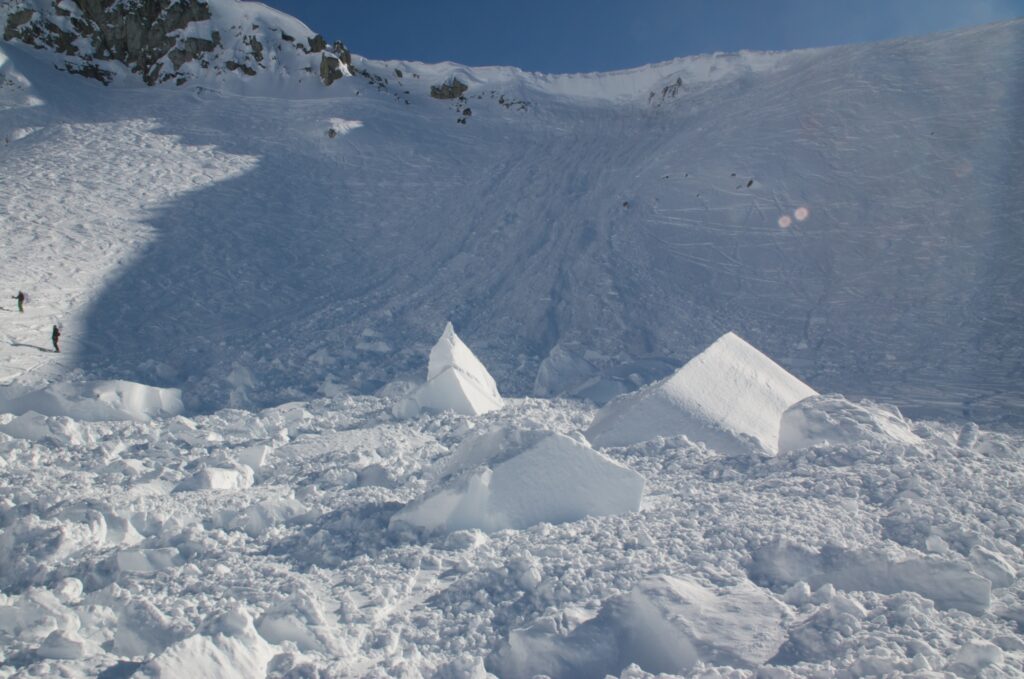
We noticed several years ago that hanging a one-kilo charge over a curling cornice nose would provide a good air-blast to the slope below, but it did not remove much of the cornice nose. This led to some experimentation with shot placement. These experiments resulted in changes to how we deploy charges along corniced ridge lines. We now train patrollers to place their roped charge on the top surface of the cornice where the charge is just out of sight. This technique has proven to be very effective at removing a much larger volume of the cornice nose because they shear farther back, leaving behind vertical faces.
As cornices get larger they become more resistant to explosives testing. Cornices can quickly exceed a size where one-kilogram charges will
produce acceptable results. The obvious adjustment is to simply use bigger charges, but there is a downside to this approach. Bigger charges may effectively trim the cornice, but their results can also present some long term problems. Large charges tend to take “bites” out of cornices. This seems to be true of every charge size from 4-26 kg. The size of the bite varies, but rarely do we see a result with a nice vertical wall. These bites can result in very rapid rebuilding of the cornice. The holes in the edge of the cornice line can quickly bridge over resulting in even bigger cornices that are now attached to the ice-hard root created by the heat from the detonation.
We found a way to take care of cornices without these side effects. When larger cornices are hanging out over our terrain and regular hand
charging will not clean up the hazard, we get out the detonator cord and link pairs of charges together. We refer to these linked charges on the surface as “Y” shots.
Y shots have proven so effective that they have almost eliminated my favourite kind of avalanche blasting from our operation: long-linked detonator cord missions. Y-shots are typically two doubles or triples linked by detonator cord and placed about 10m apart on the roof of a relatively mature cornice. The effect is amazing for such a simple, fast technique. We can remove relatively large cornices quickly, with little or no residual over-hang in about the same time it takes to deploy a few hand charges.
Y-shots are both a safe and effective means of addressing cornice hazard. With Y-shots there is no need to approach the cornice edge, as the
charges can be delivered from a safe distance and the pig tail tied to the trunk line in the safe zone. Despite the success of the Y technique, some monster cornices still form. As mentioned earlier, cornices can grow quickly during periods of mild and windy weather, and we operate until the end of May. Even a big Y-shot will not bother a 10m high cornice wall. This is when we dig out the “kerplunza” and go old school.
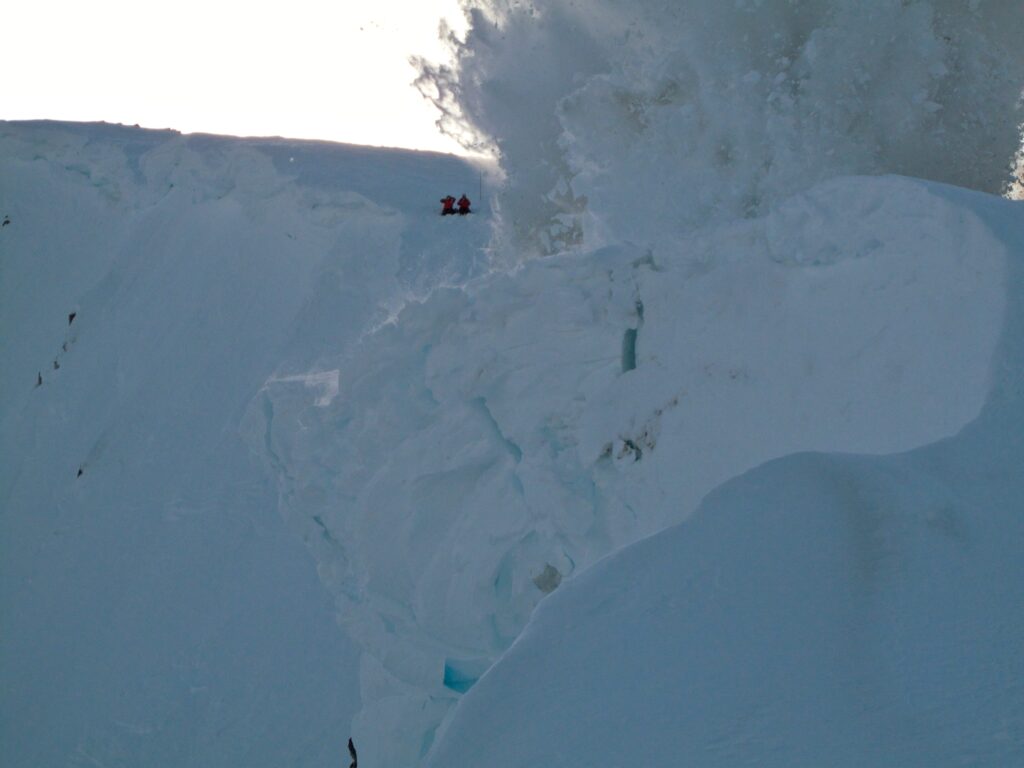
Kerplunza missions are just that: missions. Two teams are required to stage these projects. A rope team is responsible for anchors, ropes and belaying the blasting crew. The blast crew is responsible for establishing the “safe line,” assembling the charges with pig tails and a trunk line, ensuring the danger zone remains clear, and sharing the kerplunza duties. The safe line is set behind the cornice roof and no one is allowed to venture past it. While it is very important that everyone be focused and attentive to detail, these projects can be fairly social affairs.
In case you haven’t had the pleasure, a kerplunza is made of tapered steel pipe with a t-handle on one end, about 1.5m long and weighing about 25kg. This delicate bit of technology is driven into the snow until the handle is at the surface, creating 1.5m-deep hole for each charge used in the blast. A big cornice can require 15 to 25 holes. We’ve talked about using an auger, but that seems too refined.
In the past we spaced the holes at about 2-2.5m and used 2kg charges in each hole. This worked reasonably well, but we occasionally ran into the “bite” problem. We now make more holes, approximately 1.5m apart and we only place a 1kg charge in each hole. This requires that more time and effort be expended working the kerplunza, but the result is usually a beautiful plumb wall of completely smooth, hard snow with minimal “bite marks” along the ridge line.
In my opinion, if you are going to blow stuff up you may as well go big, and the results should look good too.



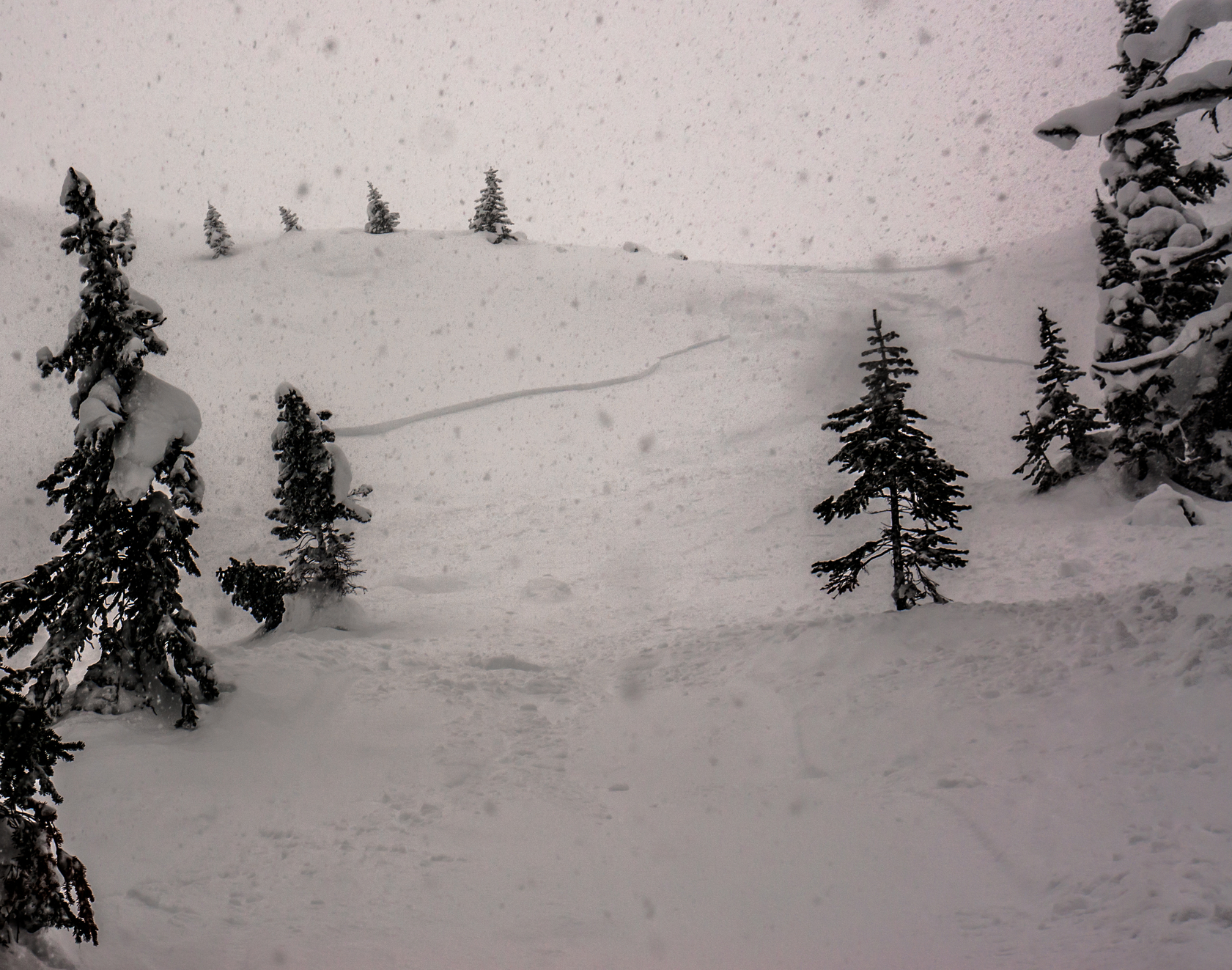
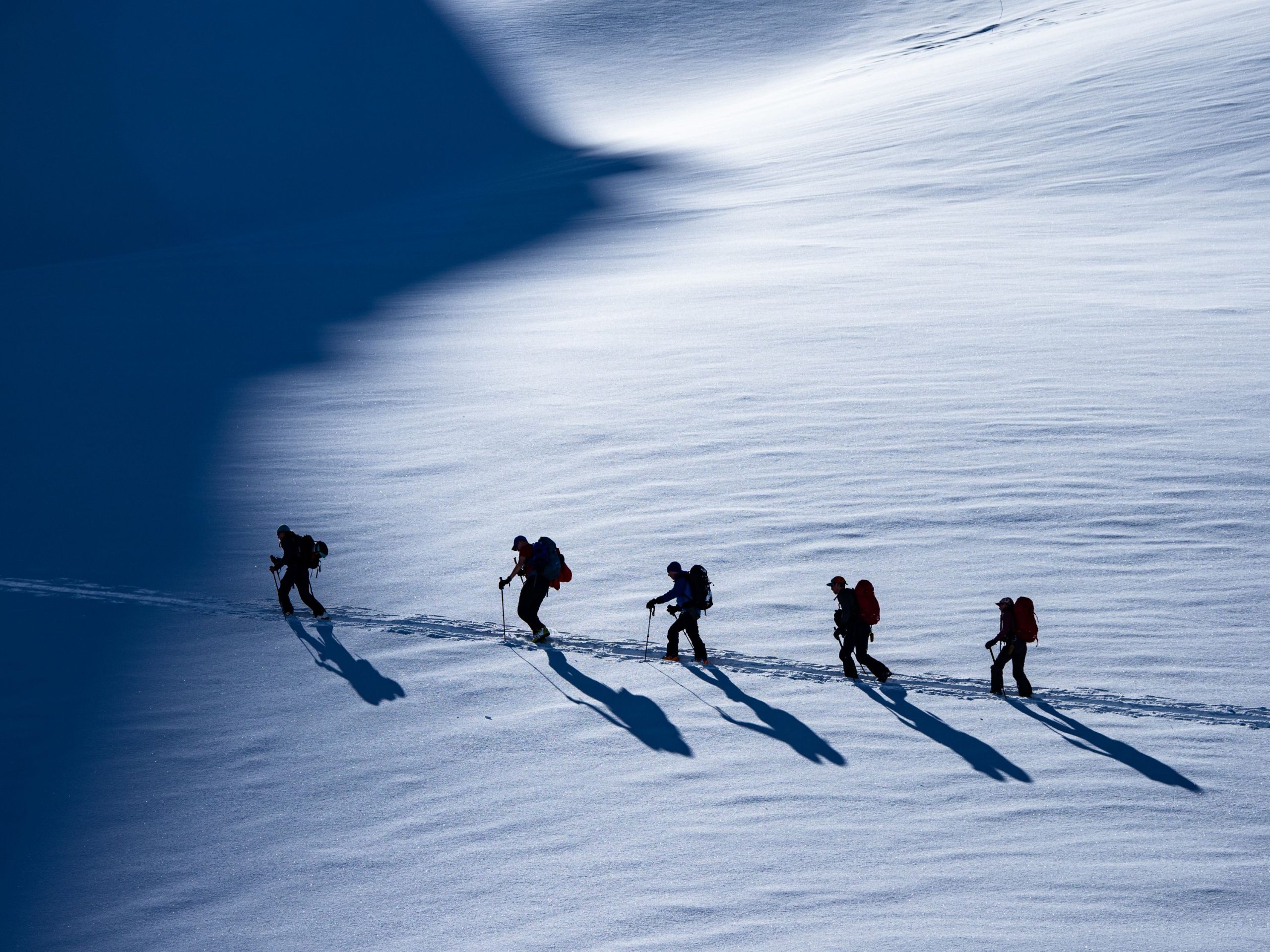
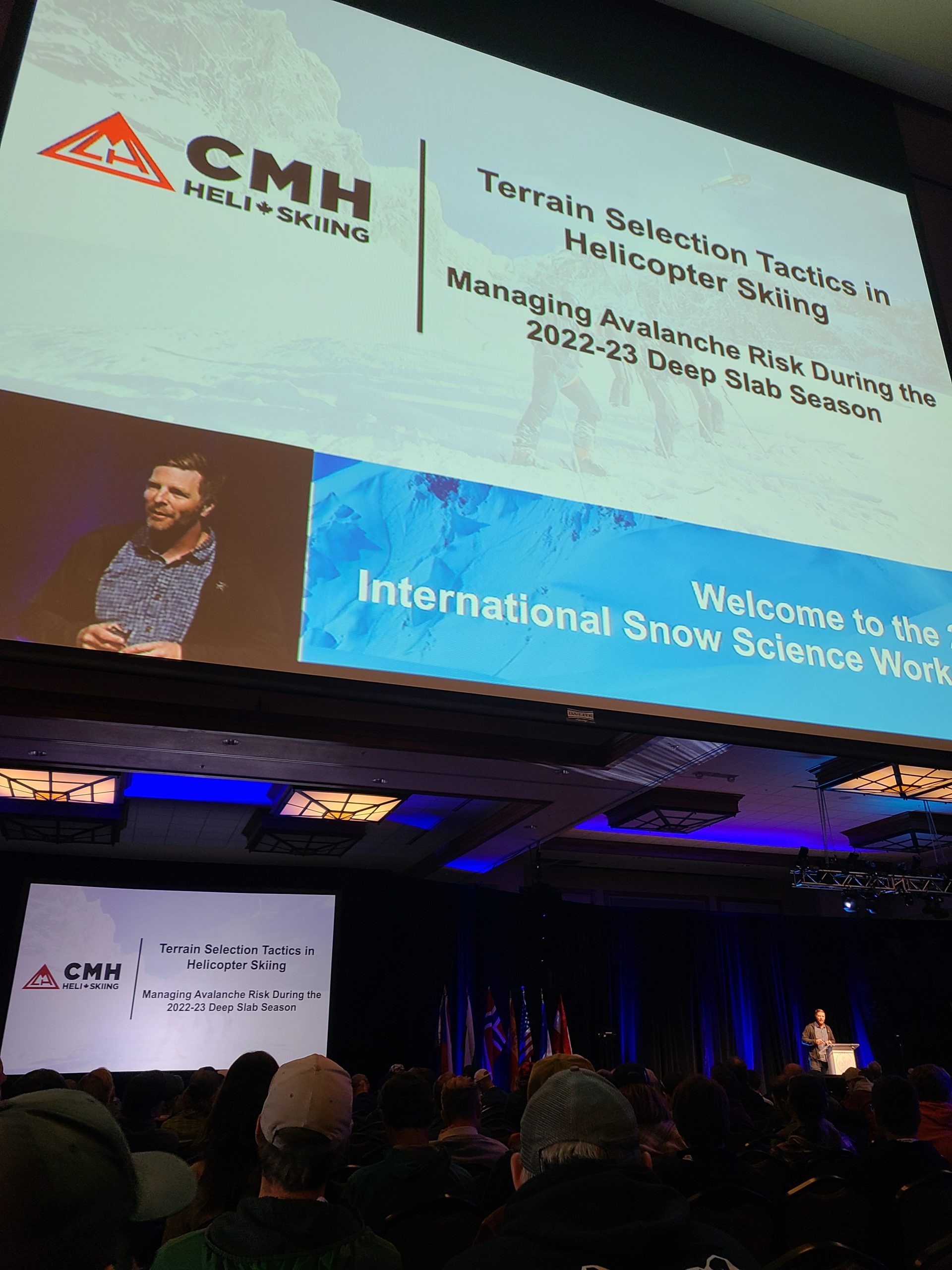
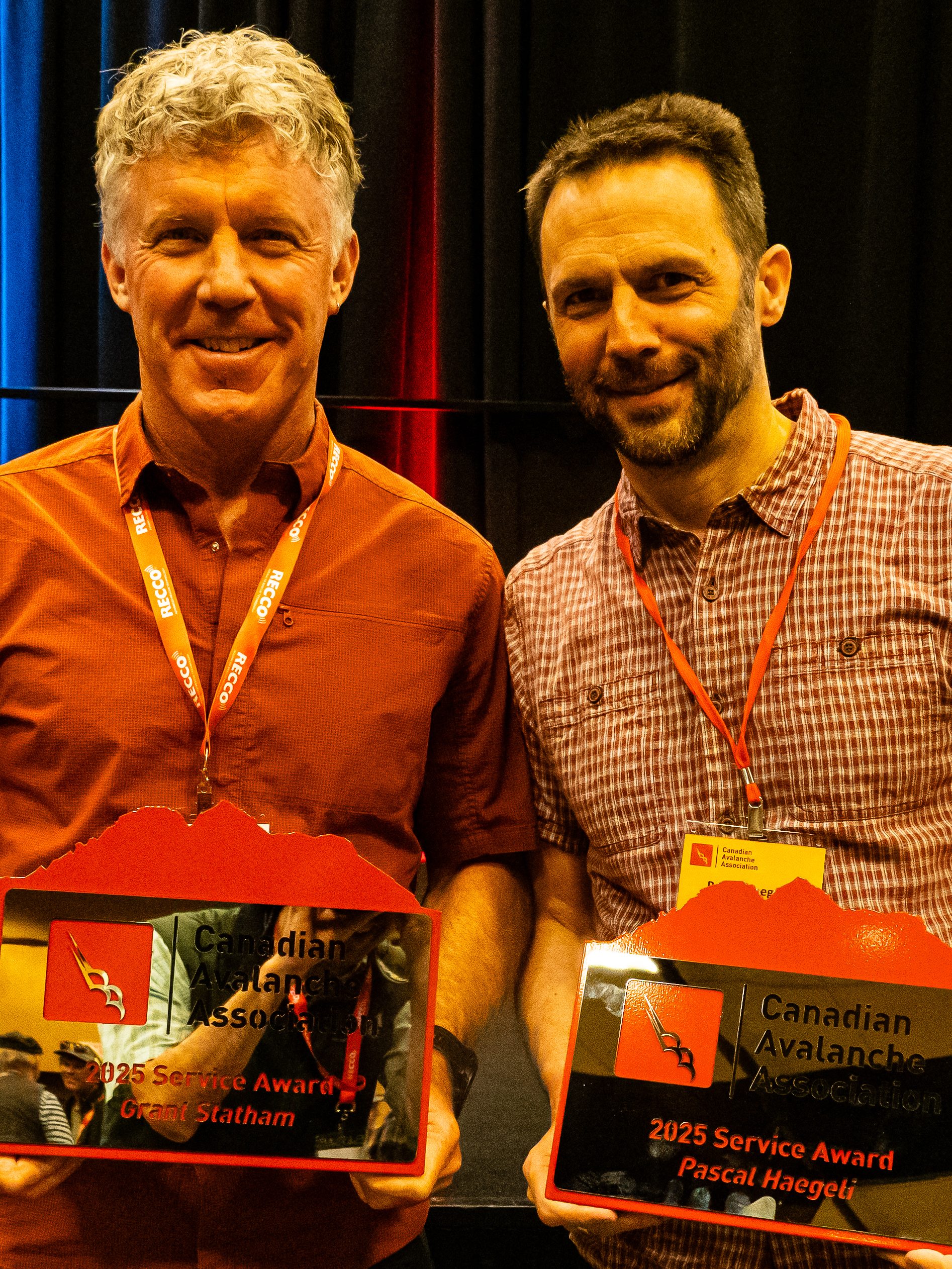

1 thought on “From the Archives: The Cornice Challenge—Part 2”
Pingback: From the Archives: The Cornice Challenge—Part 1 – Avalanche Journal
Comments are closed.